The window sill is a slab built into the lower part of the window opening. Install it at the level of the lower bar of the window frame or directly below it. The main functions are to distribute heat throughout the room, prevent heat leakage by increasing the thickness of the warm air gap and collect condensate, thereby preventing moisture from flowing onto the walls. The window sill makes it easier to care for the window, in some cases it can serve as a shelf for placing flowers, which gives the window opening a finished and aesthetic look.
Varieties of window sills
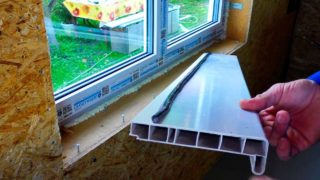
A wide range of materials used by manufacturers of window sill boards provides customers with the opportunity to choose products of various price categories, taking into account personal preferences and the characteristics of the interior of the room. The most popular materials from manufacturers are:
- polyvinyl chloride (PVC);
- wood;
- Chipboard and MDF;
- natural and artificial stone.
Planks made of ceramic tiles are much less common; porcelain stoneware, wood-polymer composite (WPC), etc.
Wooden window sills
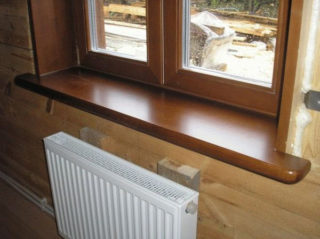
Advantages of wooden window sill boards:
- high strength, especially if oak, beech or larch were used in the manufacture;
- noble appearance;
- ecological cleanliness;
- excellent thermal insulation characteristics;
- pleasant to the touch surface, etc.
Manufacturers are constantly working to improve the quality and performance of products. The wood is well dried and subjected to processing that protects against moisture and temperature extremes. The unique structure of the tree is emphasized.
Of the shortcomings, the most important is considered to be a high demand for care, which consists in periodically covering surfaces with special wax, varnish, etc.
PVC window sills
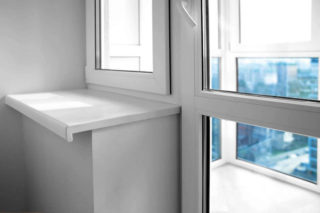
Plastic window sills have many advantages:
- structural strength, depending on the number and placement of internal stiffeners;
- light weight;
- easy installation;
- resistance to external influences;
- unpretentious care, etc.
PVC products are distinguished by a low price and a large range of colors and textures, which is ensured by the use of decorative films. This allows the use of plastic boards in a set with windows made of different materials, including wood.
Among the disadvantages:
- the ability to "absorb" pollution;
- the appearance of yellowness on the outer surface;
- low wear resistance.
It is difficult to call environmentally friendly PVC window sills.
Stone products
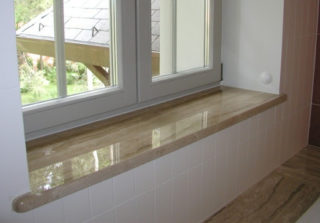
Materials imitating natural stone are distinguished by their low weight and lower price. Window sills made of natural and artificial stone look elegant and respectable, which makes it possible to fit them into exclusive interiors.
Advantages:
- resistance to climatic influences (moisture, sun rays, temperature changes);
- high strength;
- anti-flammability;
- environmental friendliness;
Artificial stones can repeat the color, texture and structure of any breed of natural material.
Natural stone can have a heterogeneous structure and internal defects. Some rocks, such as marble, can absorb dirt and have poor durability. Granite is more resistant to external influences, but has a less pronounced structure. It is not easy to obtain a curved surface from natural stone.
Artificial stone can be given any shape, dirt is not absorbed into it. Scratches appearing on its surface can be removed by sanding.
Window sills made of MDF and chipboard
Chipboard products are a cheap replacement for natural wood or stone window sills. They are united by their good performance - they can be veneered with natural wood, laminated or faced with plastic and PVC film. In this way, any material can be imitated, however, the durability of products from these plates is questionable.
Product selection

Having stopped your choice on any model, check the availability of the necessary documents and certificates that confirm the compliance of its characteristics with the declared manufacturer. It will not be superfluous to familiarize yourself with the quality certificate issued by the sanitary services. This is especially important when choosing budget models in the production of which materials of dubious origin may be used. For example, in the manufacture of chipboard, resins that release formaldehyde are used. The accompanying documentation of such products must indicate the amount of its emission - E0 and E1 are allowed. MDF boards are a little more expensive, but they are devoid of this drawback.
When choosing a window sill, pay attention to the parameters of the room - constant temperature and its drops, as well as the level of humidity. The board should not be afraid of exposure to direct sunlight and high humidity, as well as aggressive cleaning agents.
It is necessary to pay attention to the mechanical strength of the window sill itself and its outer surface. Heavy flowerpots should not leave marks.
Installation of a window sill on plastic windows

Before purchasing a window sill, you need to decide on its geometric dimensions:
- Measure the width of the opening directly at the window frame and from the side that is closer to the room.
- The maximum opening width increases by 2-4 cm, which will allow you to hide the edges of the window sill in the slopes. The resulting size will determine the length of the sill.
- Measure the width of the wall to the window. The result obtained is increased by 8-10 cm, which will give the desired width of the window sill.
To quickly and efficiently dismantle and / or install a plastic sill board, you need to prepare tools and materials:
- building level;
- roulette;
- hammer drill or drill;
- chisel;
- a hammer;
- hacksaw;
- sandpaper;
- low-expanding polyurethane foam and a spray gun;
- assembly knife;
- wedges from boards of a small section;
- paint for slopes.
Window sills made of stone or plastic are cut with a grinder; for cutting boards made of wood, chipboard and MDF, it is recommended to use a jigsaw.

Having adjusted the window sill in length and width, they begin installation work:
- In the slopes of the window opening, grooves are made with a perforator, where the edges of the board will be inserted.
- Clean the installation site of the window sill from dust and debris.
- Try on the window sill by inserting the edges into the grooves of the window profile and slopes.
- With a step of at least 40 cm, wooden wedges are laid under the board, starting from the edges. The wedges should not protrude beyond the wall.
- Using wedges, the window sill is aligned horizontally, given that the surface of the board should have a slope of about 0.2 cm from the window frame to the room so that water does not flow onto the walls.
- Having aligned the board horizontally, it is removed from the grooves. Remove the protective film from the edges and carefully install the window sill in place.
- Having checked the horizontal position again, blowing foam under the windowsill.
- A load weighing 10-20 kg is placed on the board. Foam on the outer surface is removed with a cloth. If it is frozen, remove it with a special solvent.
- After 24 hours, the load is removed, the excess foam is cut from the bottom and the protective film is removed from the surface of the windowsill. If necessary, the ends are closed with special plugs.
When installing a wooden window sill, its inner side is protected with felt impregnated with an antiseptic. Felt is fastened with shingles. The ends of stone window sills are protected with a layer of felt before installation.
Dismantling the old window sill
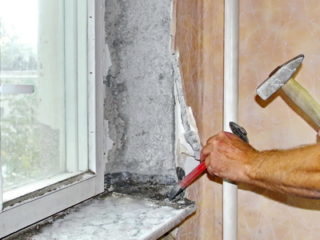
It is not difficult to dismantle an old or worn out window sill. The only condition is attention, caution and accuracy.
Products fixed with polyurethane foam are dismantled as follows:
- With a chisel and a hammer, they gently beat off the plastered slopes.
- The polyurethane foam is cut off with a sharp assembly knife.
- The window sill is pulled away from its place with a sharp movement upward and towards oneself.
The wooden sill board is removed with a hammer and crowbar. In some cases, you may need a chisel and a hacksaw. Starting dismantling, you need to hit the board with a hammer several times from below. Then they try to lift it with a crowbar and pull it out. If it doesn't work out, gently break the plaster on the slopes with a chisel and hammer, cut the board into several pieces and pull them out.
The old concrete window sill is dismantled by breaking it with a puncher or cutting it off with a grinder.








